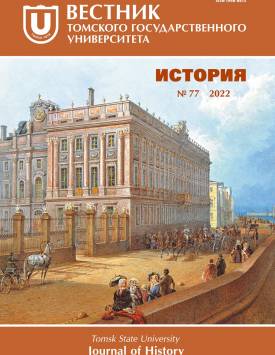Orthodoxy in the cities of nationalizing Uzbekistan in the 2010s
The article gives a brief description of the state policy towards Orthodoxy in the “Russian Turkestan” during the Soviet period in the Uzbek SSR, in the nationalizing Uzbekistan. The purpose of this article is to analyze the processes occurring in the religious consciousness and ritual life of the Orthodox, in the conditions of a decline in the percentage of Russians in post-Soviet Uzbekistan. The empirical basis of the research is a field work. The author collected about 60 semi-structured interviews. Russians, Tatars, Uzbeks, Tajiks, Germans, and others - all those who belong to the group of the Russian-speaking population of Uzbekistan were interviewed by the author. It was found that the national model of the state adopted by the government of the first President Islam Karimov, which called for combating religious extremism in the 1990s, did not allow for the politicization of Islam. It found itself in the sphere of everyday culture and in the same position as in the USSR. Accordingly, Orthodoxy also does not play a special role in the hierarchy of identities of “secular” Uzbekistan. The Russian Orthodox Church in Uzbekistan cannot do missionary activities, which leads to a decline in the parishioners because of the outflow of the Russian population from Uzbekistan. The situation in 4 Orthodox parishes in the cities of Uzbekistan was studied. Based on the data obtained, it can be concluded that in the cities of the Tashkent region (Angren and Almalyk) the proportion of Orthodox believers is smaller. These cities were formed as Soviet industrial centers, and the Orthodox communities in them were actually consolidated after the collapse of the USSR. Fergana has a higher activity of the Orthodox parish, which is related both to the history of Orthodoxy in the city and to the personality of the priest, who managed to unite the Orthodox community of the city. The study highlighted common problems noted in interviews of Orthodox priests, which are characteristic of people from ethnically and religiously mixed unions / marriages: religious syncretism, ritual acceptance of canons of Orthodoxy. At the same time, it is necessary to note the positive attitude and interest of the indigenous Muslim population of the region to the Orthodoxy. Despite the favorable conditions for the development of Orthodoxy in the Republic of Uzbekistan, the further fate of the Orthodox parishes of cities will depend on the migration activity of the Russian population. Orthodox parishes in the future are likely to become fewer, but they can become cohesive communities. Under the conditions of a nationalizing Uzbekistan, the identification markers of Russian / Russian speakers are adapted to the new socio-political and sociocultural conditions. The ethnic identity of Russians and identification with Orthodoxy are eroding most rapidly. The author declares no conflicts of interests.
Keywords
Orthodoxy, parish, Orthodox rite, religious syncretismAuthors
| Name | Organization | |
| Tsyryapkina Yulia N. | Altai State Pedagogical University | guzvenko@yandex.ru |
References

Orthodoxy in the cities of nationalizing Uzbekistan in the 2010s | Tomsk State University Journal of History. 2022. № 77. DOI: 10.17223/19988613/77/20
